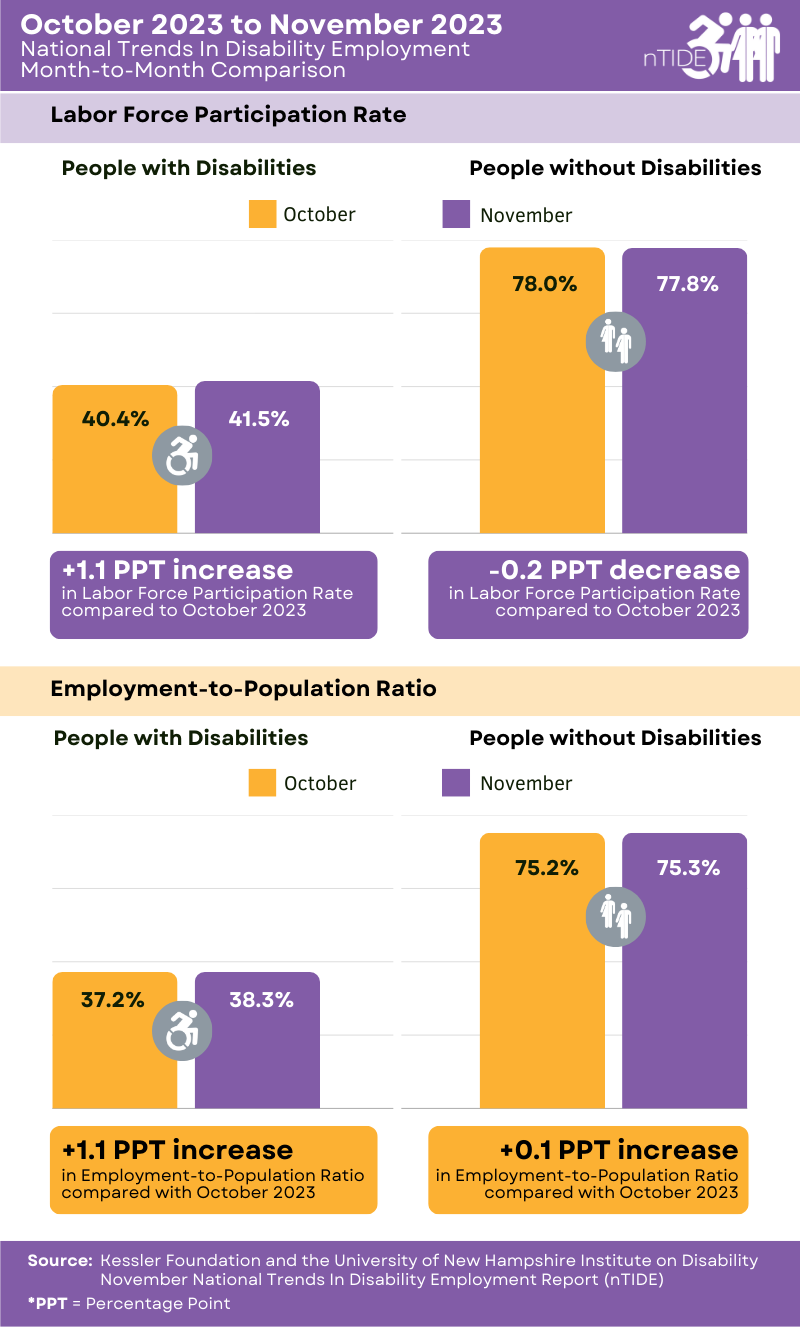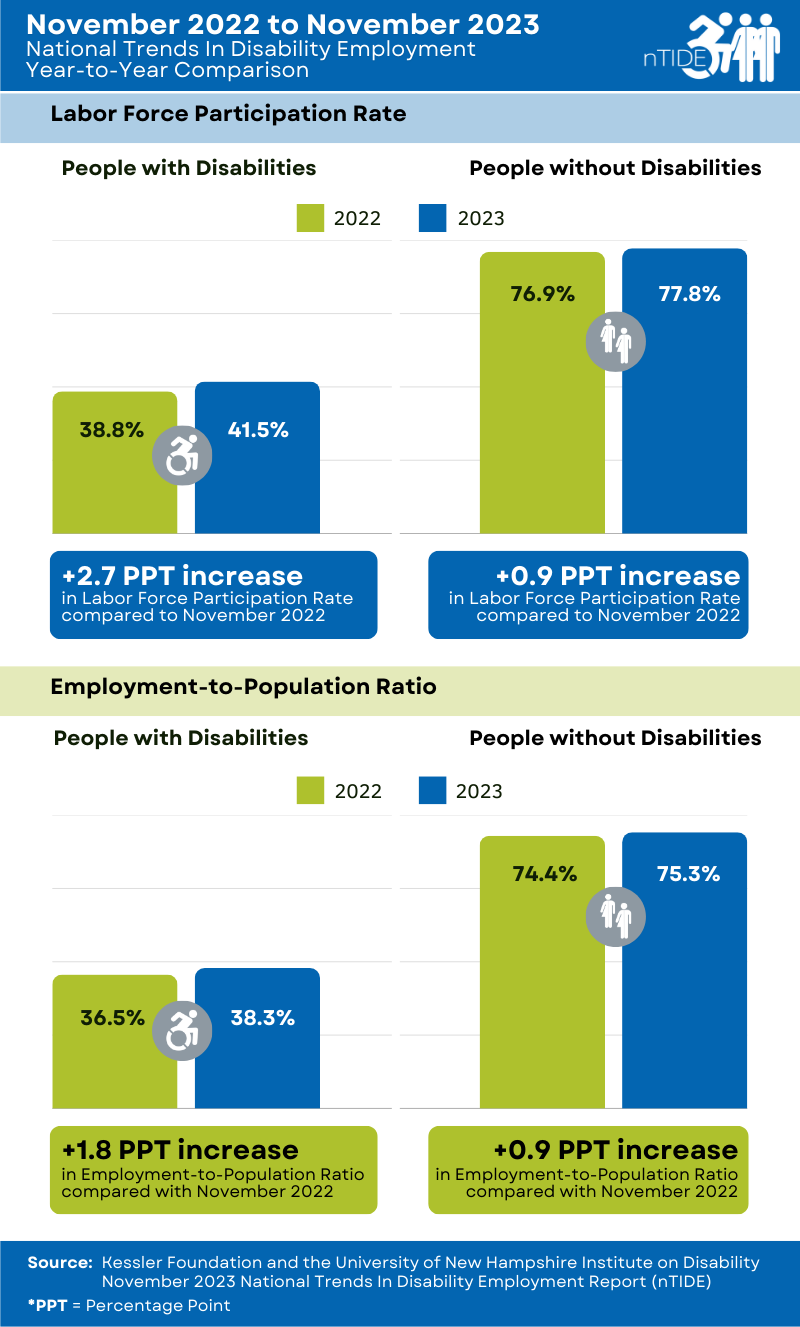National Trends in Disability Employment (nTIDE) – Issued semi-monthly by Kessler Foundation and the University of New Hampshire
East Hanover, NJ – December 8, 2023 – People with disabilities reached new highs for both employment-to-population ratio and labor force participation, bucking the economy’s cooling trend, according to today’s National Trends in Disability Employment – semi-monthly update (nTIDE), issued by Kessler Foundation and the University of New Hampshire’s Institute on Disability (UNH-IOD). In comparison, these economic indicators remained flat for people without disabilities.
Month-to-Month nTIDE Numbers (comparing October 2023 to November 2023)
Based on data from the U.S. Bureau of Labor Statistics (BLS) Jobs Report released today, the employment-to-population ratio for people with disabilities (ages 16-64) increased from 37.2 percent in October 2023 to 38.3 percent in November 2023 (up 3.0 percent or 1.1 percentage points). For people without disabilities (ages 16-64), the employment-to-population ratio increased from 75.2 percent in October 2023 to 75.3 percent in November 2023 (up 0.1 percent or 0.1 percentage points). The employment-to-population ratio, a key indicator, reflects the percentage of people who are working relative to the total population (the number of people working divided by the number of people in the total population multiplied by 100).

the employment-to-population ratio and the labor force participation rate for people with disabilities. Minimal
changes in both indicators for people without disabilities indicate that employment remained unchanged.
“In November, the employment-to-population ratio for people with disabilities reached an all-time high, topping 38 percent for the first time since the data started being collected in 2008,” according to John O’Neill, PhD, director of the Center for Employment and Disability Research at Kessler Foundation. “This is excellent news particularly considering that the employment trend for people without disabilities remains flat,” he added.
Similarly, the labor force participation rate for people with disabilities (ages 16-64) increased from 40.4 percent in October 2023 to 41.5 percent in November 2023 (up 2.7 percent or 1.1 percentage points). For people without disabilities (ages 16-64), the labor force participation rate decreased from 78 percent in October 2023 to 77.8 percent in November 2023 (down 0.3 percent or 0.2 percentage points). The labor force participation rate reflects the percentage of people who are in the labor force (working, on temporary layoff (on furlough), or actively looking for work in the last four weeks) relative to the total population (the number of people in the labor force divided by the number of people in the total population multiplied by 100).
“While the overall economy is cooling, people with disabilities are engaging in the labor force at record rates,” said Andrew Houtenville, PhD, professor of economics and research director of the UNH-IOD. “Of course, there is a long way to go before the gap between people with and without disabilities is closed,” he emphasized.

for both indicators for people with and without disabilities.
Year-to-Year nTIDE Numbers (comparing November 2022 to November 2023)
Compared to this time last year, the employment-to-population ratio for people with disabilities (ages 16-64) increased from 36.5 percent in November 2022 to 38.3 percent in November 2023 (up 4.9 percent or 1.8 percentage points). For people without disabilities (ages 16-64), the employment-to-population ratio also increased from 74.4 percent in November 2022 to 75.3 percent in November 2023 (up 1.2 percent or 0.9 percentage points).
Likewise, the labor force participation rate for people with disabilities (ages 16-64) increased from 38.8 percent in November 2022 to 41.5 percent in November 2023 (up 7.0 percent or 2.7 percentage points). For people without disabilities (ages 16-64), the labor force participation rate also increased from 76.9 percent in November 2022 to 77.8 percent in November 2023 (up 1.2 percent or 0.9 percentage points).
In November, among workers ages 16-64, the 6,460,000 workers with disabilities represented 4.3 percent of the total 150,966,000 workers in the U.S.
Ask Questions about Disability and Employment
Each nTIDE release is followed by an nTIDE Lunch & Learn online webinar. This live broadcast, hosted via Zoom Webinar, offers attendees Q&A on the latest nTIDE findings, provides news, updates from the field, and features invited panelists who discuss current disability-related findings and events.
On December 8, 2023, at 12:00 pm – 1:00 pm Eastern, guest presenter Rachel Pollock, senior program advisor and general counsel, Job Path, Inc., joins Dr. Houtenville and Elaine E. Katz, MS, CCC-SLP, senior vice president of grants and communications at Kessler Foundation. Join our free Lunch & Learn live or visit the nTIDE archives at: ResearchonDisability.org/nTIDE.
NOTE: The statistics in the nTIDE are based on BLS numbers but are not identical. They are customized by UNH to combine the statistics for men and women of working age (16- 64). nTIDE is funded by Kessler Foundation and was initially funded by grants from the National Institute on Disability, Independent Living and Rehabilitation Research (NIDILRR) (90RT5037).
About nTIDE Updates
National Trends in Disability Employment (nTIDE) is a joint project of Kessler Foundation and the University of New Hampshire Institute on Disability. The nTIDE team closely monitors the job numbers, issuing semi-monthly reports that track the impact of economic shifts on employment for people with and without disabilities. As the effect of the COVID-19 pandemic continues to wane and inflation persistently rises, the nTIDE team has superseded its mid-month COVID Update to a “Deeper Dive” into the BLS data for people with disabilities.
About the Institute on Disability at the University of New Hampshire
The Institute on Disability at the University of New Hampshire was established in 1987 to provide a university-based focus for the improvement of knowledge, policies, and practices related to the lives of persons with disabilities and their families. For information on the Intitute’s NIDILRR-funded Rehabilitation Research and Training Center on Disability Statistics and Demographics (StatsRRTC), visit ResearchOnDisability.org
About Kessler Foundation
Kessler Foundation, a major nonprofit organization in the field of disability, is a global leader in rehabilitation research. Our scientists seek to improve cognition, mobility, and long-term outcomes, including employment, for adults and children with neurological and developmental disabilities of the brain and spinal cord including traumatic brain injury, spinal cord injury, stroke, multiple sclerosis, and autism. Kessler Foundation also leads the nation in funding innovative programs that expand opportunities for employment for people with disabilities.